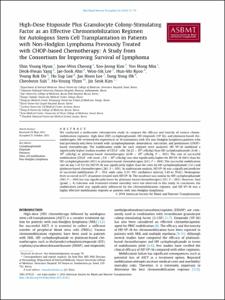KUMEL Repository
1. Journal Papers (연구논문)
1. School of Medicine (의과대학)
Dept. of Internal Medicine (내과학)
High-Dose Etoposide Plus Granulocyte Colony-Stimulating Factor as an Effective Chemomobilization Regimen for Autologous Stem Cell Transplantation in Patients with Non-Hodgkin Lymphoma Previously Treated with CHOP-based Chemotherapy: A Study from the Consortium for Improving Survival of Lymphoma
- Affiliated Author(s)
- 도영록
- Alternative Author(s)
- Do, Young Rok
- Journal Title
- Biology of Blood and Marrow Transplantation
- ISSN
- 1083-8791
- Issued Date
- 2014
- Abstract
- We conducted a multicenter retrospective study to compare the efficacy and toxicity of various chemomobilization regimens: high-dose (HD) cyclophosphamide, HD etoposide (VP-16), and platinum-based chemotherapies. We reviewed the experiences of 10 institutions with 103 non-Hodgkin lymphoma patients who had previously only been treated with cyclophosphamide, doxorubicin, vincristine, and prednisone (CHOP)-based chemotherapy. The mobilization yields for each regimen were analyzed. HD VP-16 mobilized a significantly higher median number of CD34+ cells (16.22 × 106 cells/kg) than HD cyclophosphamide (4.44 × 106 cells/kg) or platinum-based chemotherapies (6.08 × 106 cells/kg, P < .001). The rate of successful mobilization (CD34+ cell count ≥5.0 × 106 cells/kg) was also significantly higher for HD VP-16 (86%) than for HD cyclophosphamide (45%) or platinum-based chemotherapies (61%, P = .004). The successful mobilization rate on day 1 of 72% for HD VP-16 was significantly higher than the rates for HD cyclophosphamide (13%) and platinum-based chemotherapies (26%, P < .001). In multivariate analysis, HD VP-16 was a significant predictor of successful mobilization (P = .014; odds ratio, 5.25; 95% confidence interval, 1.40 to 19.63). Neutropenic fever occurred in 67% of patients treated with HD VP-16. The incidence was similar for HD cyclophosphamide (58%, P = .454) but was significantly lower for platinum-based chemotherapies (12%, P < .001). However, fatal (grade ≥ 4) infection and treatment-related mortality were not observed in this study. In conclusion, the mobilization yield was significantly influenced by the chemomobilization regimen, and HD VP-16 was a highly effective mobilization regimen in patients with non-Hodgkin lymphoma.
Key Words
Cyclophosphamide;
Etoposide;
Platinum;
Stem cell mobilization;
Non-Hodgkin lymphoma
- Department
- Dept. of Internal Medicine (내과학)
- Publisher
- School of Medicine
- Citation
- Shin Young Hyun et al. (2014). High-Dose Etoposide Plus Granulocyte Colony-Stimulating
Factor as an Effective Chemomobilization Regimen
for Autologous Stem Cell Transplantation in Patients
with Non-Hodgkin Lymphoma Previously Treated
with CHOP-based Chemotherapy: A Study from
the Consortium for Improving Survival of Lymphoma. Biology of Blood and Marrow Transplantation, 20(1), 73–79. doi: 10.1016/j.bbmt.2013.10.012
- Type
- Article
- ISSN
- 1083-8791
- Appears in Collections:
- 1. School of Medicine (의과대학) > Dept. of Internal Medicine (내과학)
- 파일 목록
-
-
Download
 oak-aaa-00612.pdf
기타 데이터 / 259.66 kB / Adobe PDF
oak-aaa-00612.pdf
기타 데이터 / 259.66 kB / Adobe PDF
-
Items in Repository are protected by copyright, with all rights reserved, unless otherwise indicated.